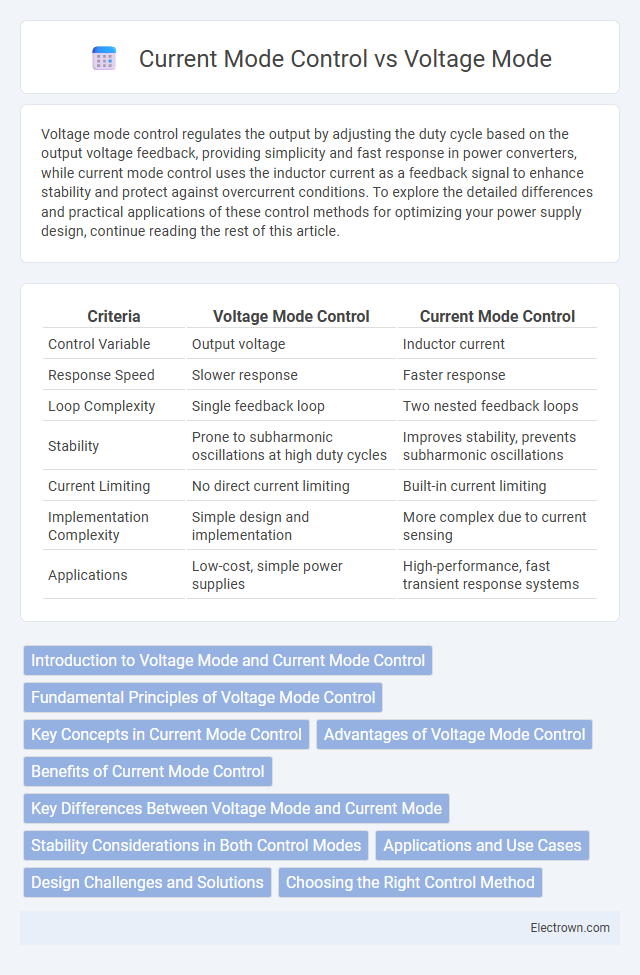Voltage mode control regulates the output by adjusting the duty cycle based on the output voltage feedback, providing simplicity and fast response in power converters, while current mode control uses the inductor current as a feedback signal to enhance stability and protect against overcurrent conditions. To explore the detailed differences and practical applications of these control methods for optimizing your power supply design, continue reading the rest of this article.
Table of Comparison
| Criteria | Voltage Mode Control | Current Mode Control |
|---|---|---|
| Control Variable | Output voltage | Inductor current |
| Response Speed | Slower response | Faster response |
| Loop Complexity | Single feedback loop | Two nested feedback loops |
| Stability | Prone to subharmonic oscillations at high duty cycles | Improves stability, prevents subharmonic oscillations |
| Current Limiting | No direct current limiting | Built-in current limiting |
| Implementation Complexity | Simple design and implementation | More complex due to current sensing |
| Applications | Low-cost, simple power supplies | High-performance, fast transient response systems |
Introduction to Voltage Mode and Current Mode Control
Voltage Mode Control regulates the output voltage by adjusting the duty cycle based on the error between the reference and feedback voltages. Current Mode Control enhances response and stability by directly controlling the inductor current, providing intrinsic overcurrent protection and simplifying loop compensation. Your choice between these methods depends on factors like transient response, complexity, and system requirements.
Fundamental Principles of Voltage Mode Control
Voltage Mode Control regulates the output voltage by adjusting the duty cycle of the power switch based on the error between the reference voltage and the output voltage. It uses a single feedback loop with an error amplifier that compares the output voltage to a set reference, producing a control signal for the pulse-width modulator (PWM). This method provides straightforward implementation and is effective for applications requiring stable voltage regulation under varying load conditions.
Key Concepts in Current Mode Control
Current Mode Control regulates the inductor current directly, providing inherent overcurrent protection and improving system response to load changes. It combines an inner current loop with an outer voltage loop to achieve fast transient response and enhanced stability by effectively converting the power stage into a current source. Key concepts include slope compensation to prevent subharmonic oscillations and peak current detection to maintain precise current regulation.
Advantages of Voltage Mode Control
Voltage Mode Control offers simplicity in implementation and design, making it ideal for applications requiring straightforward control schemes. It provides a wide bandwidth for feedback, which enhances the overall system stability and transient response. Your power supply benefits from easier loop compensation and reduced sensitivity to noise compared to current mode control.
Benefits of Current Mode Control
Current Mode Control enhances system stability by directly regulating inductor current, which improves response time and simplifies loop compensation. It provides inherent overcurrent protection, reducing the risk of component damage under fault conditions. This control method also facilitates accurate peak current sensing, leading to better performance in dynamic load situations and improved transient response.
Key Differences Between Voltage Mode and Current Mode
Voltage Mode Control regulates output voltage by adjusting the duty cycle based on the error between the reference voltage and feedback voltage, offering simplicity but slower transient response. Current Mode Control adds an inner current loop to directly regulate the inductor current, improving response time and providing inherent overcurrent protection. Your choice between voltage mode and current mode impacts system stability, transient performance, and circuit complexity depending on the specific application requirements.
Stability Considerations in Both Control Modes
Voltage mode control often faces stability challenges due to its single-loop feedback relying solely on output voltage, which can introduce phase lag and reduce phase margin, especially under varying load conditions. Current mode control enhances stability by implementing an inner current feedback loop that provides inherent overcurrent protection and improves transient response, effectively increasing the system's bandwidth and damping. Both modes require careful compensation design, but current mode control typically achieves faster dynamic response and better handling of load disturbances, making it more stable in high-performance power converters.
Applications and Use Cases
Voltage Mode Control is widely used in applications requiring simple implementation and good line regulation, such as DC-DC converters in consumer electronics and LED drivers. Current Mode Control excels in systems demanding fast transient response and precise current limiting, commonly found in power supplies for telecommunications and high-performance motor drives. Both control methods are essential in power management, with Current Mode preferred for enhanced stability in complex, high-frequency designs.
Design Challenges and Solutions
Voltage mode control faces design challenges such as limited phase margin and sensitivity to load variations, making stability and transient response difficult to optimize. Current mode control addresses these issues by providing inherent overcurrent protection and improved dynamic response, but requires careful compensation design to prevent subharmonic oscillations. Solutions include implementing slope compensation in current mode control and employing advanced compensators or adaptive control strategies to enhance voltage mode stability and performance.
Choosing the Right Control Method
Choosing the right control method between voltage mode and current mode control depends on your application's requirements for stability, response speed, and complexity. Voltage mode control offers simplicity and ease of implementation, making it suitable for systems with low noise and stable operating conditions. Current mode control provides improved transient response and inherent overcurrent protection, ideal for applications needing precise current regulation and better load handling.
Voltage Mode vs Current Mode Control Infographic

 electrown.com
electrown.com